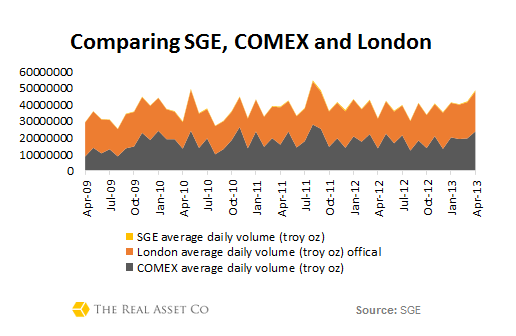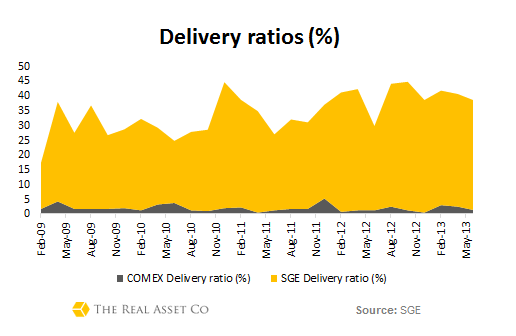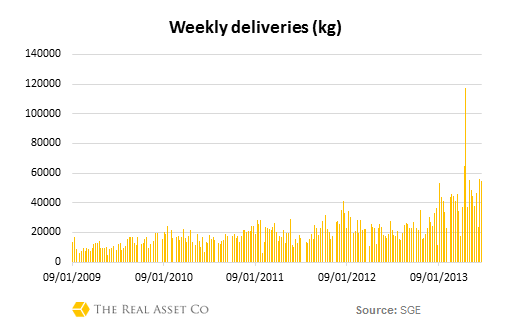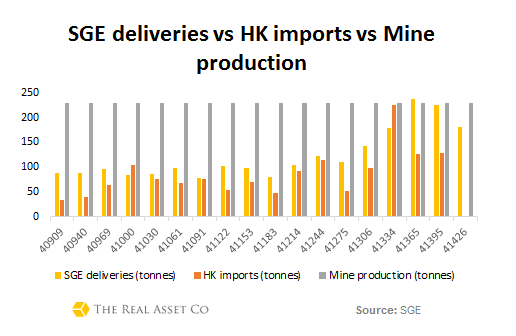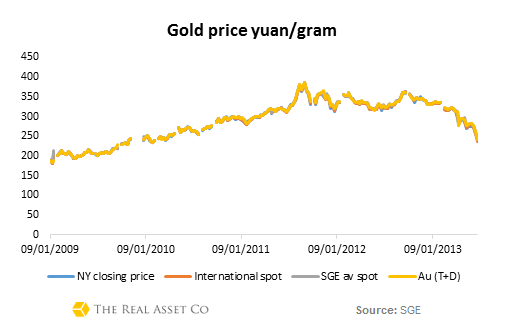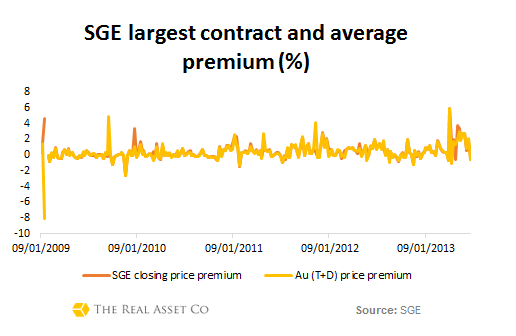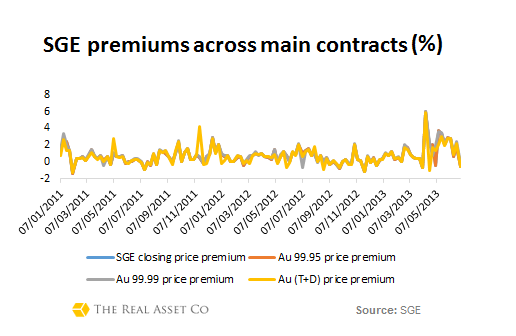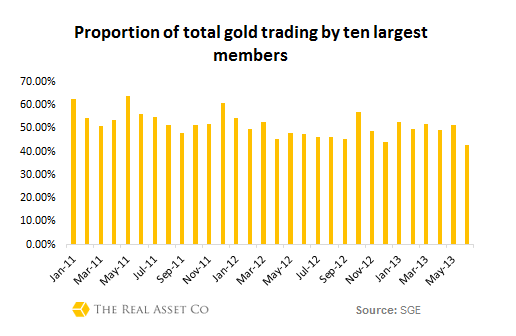Inside the White Hot Chinese Gold Market
Commodities / Gold and Silver 2013 Jul 11, 2013 - 10:18 AM GMTBy: Jan_Skoyles
 In the next part of our on-going look at the global gold market we now turn our attention to the Shanghai Gold Exchange. An exchange which has received more interest of late, than any other in the world of gold and silver.
In the next part of our on-going look at the global gold market we now turn our attention to the Shanghai Gold Exchange. An exchange which has received more interest of late, than any other in the world of gold and silver.
Previously we have looked at the global gold market, COMEX, and more recently the London Gold Market. The next logical focus of our investigations is the Shanghai Gold Exchange. We also have a great infographic providing you with the top figures.
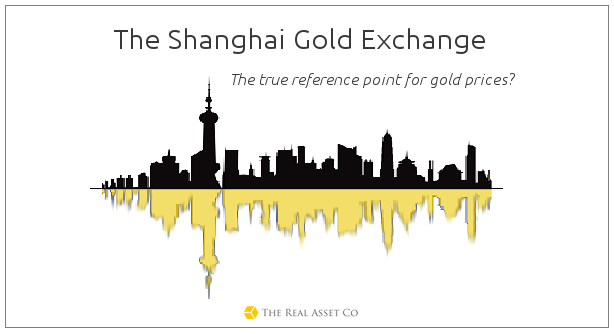
Given the significant rise of gold exports from Hong Kong to China, 68% yoy, this is a timely and informative research piece which shines a spotlight on the Eastern gold market in a time when many are declaring the end of the gold bull market. Given the huge demand for physical and reportedly high premiums on the gold price, we ask if this market may well be a better indicator of gold demand, and subsequently true gold prices, than either COMEX or London.
We do not yet believe that the SGE will become a gold price driver, but the significant volumes and deliveries seen on the exchange suggest that its role in gold price discovery will become significant…, if it is not already.
Much of the below is inspired and aided by ;@KoosJansen who has been hugely helpful on helping us to understand the workings and numbers of the SGE.
Compared to our studies of the secretive London gold market, access to data from the SGE was considerably easier to access. I hope you enjoy our deep dig into the white hot heat of the Chinese gold market.
Which contracts?
A quick glance at previous data released by the SGE previously shows that the three largest gold contracts traded on the exchange are as follows: Au 99.95 (3kg contract) Au 99.99 (1 kg) Au (T+D) (also 1kg of 99.95). These are the contracts we focus on given their monopoly on liquidity at SGE, and thus gold price setting impact.
In 2011, the total trading volume of Au 99.99 exceeded that of Au 99.95, for the first time.
This continues to be the case today -a gradually widening gap between the two contracts is clear – particularly during peak demand periods such as April this year.
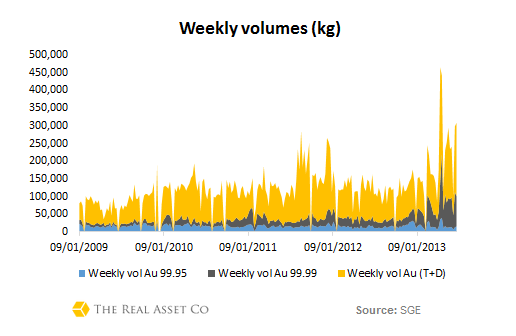
The Au (T+D) contract accounts for over 75% of activity on the SGE. When the gold price fell back in April, many gold fans were quick to point to the huge volumes being seen on the SGE. However, on a quarterly basis volumes for Au (T+D) were not as high as those seen in Q3 and Q4 2011, when the gold price climbed to, and then fell from, the all-time high of $1,920/oz.
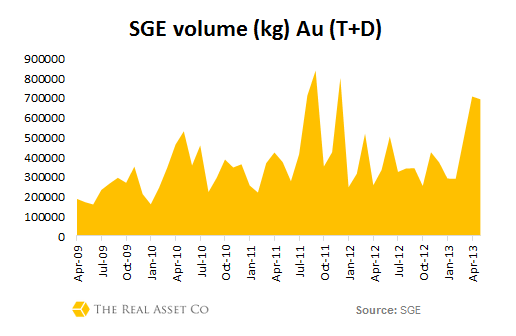
It is worth mentioning that the SGE has a night trading session. This allows it to present a price which is more in line with the ‘international price’ as well as increase in volume. According to 2011 statistics the night session accounts for one-third of total trading volume on the exchange.
Whilst the volume on the SGE may seem impressive, compared to both the London market and COMEX it is exceptionally small. In the chart below SGE is represented in yellow, or it’s supposed to be…
As we stated in our previous work on the London Gold Market, despite the significant volumes passing through our capital, price discovery can be seen in both COMEX and London, despite New York’s significantly smaller volumes.
For anyone hoping the SGE might play a very large rolein gold price discovery, this does not appear to be obvious. A future key role might indeed occur, but for now the SGE is growing in the shadows of COMEX and the London Gold Market.
Deliveries
When we looked at COMEX, we found that delivery ratios were exceptionally low given the huge volumes. We have always known that the Chinese prefer physical gold, but we were not prepared for the significant delivery number coming from the exchange.
Whilst COMEX’s delivery ratio has remained at or below 5% for the last 4 years, the SGE has consistently been above 25%.
In April the amount of gold delivered on the SGE gave way to some fanfare and even greater China watching in the gold market.
To illustrate just quite how vociferous China’s demand for physical is, we reproduce a graph below originally conceived by @KoosJansen, to which we have then added Hong Kong imports.
In just two instances in the last 18 months, Hong Kong imports have been above deliveries on the Shanghai Gold Exchange. In April, SGE deliveries famously overtook mining production, and it has hovered there in the weeks and months since then.
These transparent, recorded deliveries on the SGE represent the largest visible gold off-take anywhere in the world. All power to those Chinese housewives.
In the 2011 SGE Annual Report, the exchange states that delivery is not affected by movement in the gold price, but instead is determined by Chinese holidays. This is likely to have been the case prior to 2011, however we believe we are seeing consistent delivery numbers in 2012, which then pick up according to economic events and then the price drop in April 2013.
Vaults and inventory
Unlike COMEX, we were unable to attain data as to the SGE’s vaulting and inventory situation. The most official response on this subject can be found in the exchange’s 2011 Annual Report:
SGE’s vault management system run in good shape, with 49 vaults used for delivery involving 31 jurisdictions.
Among the vaults used, 72.06 percent were designated, fulfilling the demand for physical gold in the entity industry.
Pricing on the SGE
In a 2011 speech by the Chairman and President of the SGE, Wang Zhe, stated that one of the major features of the exchange was ‘price discovery and synchronisation’.
From the graph below we can clearly see the synchronisation as the major contracts on the exchange see similar prices to the New York closing price. In regard to price discovery however, which we discussed above, we do not see this as the case given the significantly smaller volumes.
The graph above shows very little disparity between the COMEX closing price, the ‘international spot’ (as referred to in the SGE documents) and the largest contract on the exchange.
It is most practical to compare the New York closing price with the Au (T+D) as this is the one most similar to the COMEX’s dominant 100oz contract. As an SGE representative described to the goldminerpulse website:
Simply speaking, Au(T+D) is a product with margin and position concept, i.e. you get a long position after buying and get a short position after selling. Delivery happens every day between long and short positions. So delivery volume is the volume delivered from some short positions to some long positions. It’s nothing relevant to the volume leaving the vault which is not an available data. Think about futures, delivery occurs from short positions to long positions, kind of similar concept for your understanding.
In regard to a premium, there is also little to see here. Apart from a funny anomaly at the beginning of January 2009, which we believe is down to a misprint in the SGE documents, it appears premiums rarely reach above 2%.
Nor does there appear a significant premium when you look at contracts that are available for immediate delivery.
In the last month or so, however there has been a larger than normal premium for both the Au 99.9 and Au 99.95 contracts.
We should keep an eye on this for a continued trend and any ruptures in gold price between locations.
Active members
We thought we would take some time to look at the most active members of the SGE. According to SGE data, trading of members accounts for around 50% of total activity on the SGE.
As the Chairman and President of the SGE, Wang Zhe said in a 2011 speech: ‘though institutional clients are still the most important participants in the market, the market share of individual investors has soared in recent years. This is clear, particularly in the last month when institutional activity has only accounted for 42%.’
Concluding remarks
Chinese gold demand, from both individuals and central banks, garnered increasing attention as the gold price rose consistently in the last twelve years. When the gold price declined, many in the West declared the end of gold, but China (along with many other Asian nations) defiantly continued to buy gold and increase their imports.
Questions over the legitimacy and transparency of COMEX and the London Gold markets are now becoming louder, especially as increasing numbers of institutions are keen to know what actually backs those contracts. ‘Paper gold’ is on everyone’s lips.
When it comes to the SGE, there seems to be little concern over the presence of physical gold, given the increasing volumes of activity in the three largest contracts, two of which are available for immediate delivery. Delivery ratios are significantly higher than those on COMEX, showing the far higher of physical participation in this market.
Whilst the gold price is unlikely to be powered by the SGE, as long as the vast volumes of paper gold exist on both COMEX and London, we do believe that the SGE could end updriving the wedge between the paper gold and physical gold market, and therefore disparities in price between what market participants would deem two different products.
Physical gold demand in the most populated country on earth does not seem to be subsiding, yet neither do COMEX and futures volumes generally.
We believe that as increasing numbers of Westerners look to take delivery of their gold from Western exchanges, there will be more pressure on the physical market. China’s primary physical exchange, as we see from delivery data, is the liquidity hub with the best reputation for such demand.
In this brief look at the China gold market, we have not presented either wholesale or retail premiums.
However anecdotal and media reports show that this is an ongoing phenomenon. Unlike investors in the West, Chinese housewives just want physical gold regardless of the price. This is clearly evident in the delivery data on the SGE, unlike in the West where we see gold as an investment which we hope will climb in price, the Chinese see gold as a way to free up devalued cash and place it into a real store of value.
We are watching a fascinating battle play out between this army of Chinese retail buyers and the specs in the West. The future of the gold price is there for the taking.
Like our research? Get it first in our fortnightly newsletter.
Jan Skoyles contributes to the The Real Asset Co research desk. Jan has recently graduated with a First in International Business and Economics. In her final year she developed a keen interest in Austrian economics, Libertarianism and particularly precious metals. The Real Asset Co. is a secure and efficient way to invest precious metals. Clients typically use our platform to build a long position and are using gold and silver bullion as a savings mechanism in the face on currency debasement and devaluations. The Real Asset Co. holds a distinctly Austrian world view and was launched to help savers and investors secure and protect their wealth and purchasing power.
© 2013 Copyright Jan Skoyles - All Rights Reserved Disclaimer: The above is a matter of opinion provided for general information purposes only and is not intended as investment advice. Information and analysis above are derived from sources and utilising methods believed to be reliable, but we cannot accept responsibility for any losses you may incur as a result of this analysis. Individuals should consult with their personal financial advisors.
Jan Skoyles Archive |
© 2005-2022 http://www.MarketOracle.co.uk - The Market Oracle is a FREE Daily Financial Markets Analysis & Forecasting online publication.




